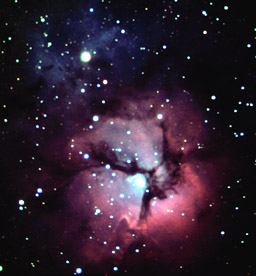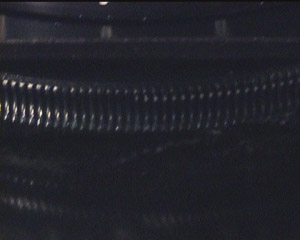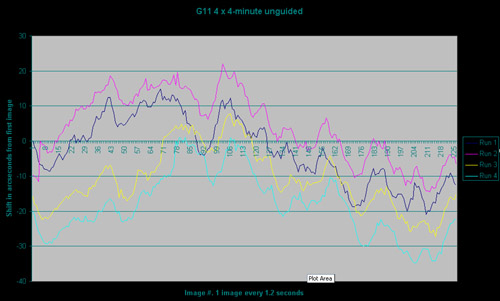
G11 Issues

9 x 30-second images showing mis-tracking for one turn of the RA worm.
I recently acquired a new Losmandy G11 Mount to complement a new C11 ota. The primary aim was to take colour ccd images at focal lengths from 1700mm and higher. Having had great success with unguided imaging and my old Vixen GP-DX mount (capable of consistent perfect tracking over 3-minute exposures at 1260mm f.l. or perhaps more-importantly at 2 arcseconds per pixel), I fully expected the G-11 to way surpass the performance of the GP-DX but it didn't.
The first thing I noticed was a glitch in RA which saw stars jump by around 6 arcseconds, every 30 seconds or so. The end result of this was that any image of greater than 30 seconds duration had double stars in it. Sometimes triple stars. Most of the time, the shift was only in RA, but occasionally, there would be some dec movement as well. Sometimes mutliple stars would be in a triangular formation. This dec movement almost certainly has to be atmospheric as the mount is polar aligned and running in polar aligned mode, should not be tracking in dec at all.
Scouring the internet for information (as always), I found a host of other GM8 / G11 owners who's mounts suffered identical symptoms (same as when I started researching my C11 problems). Actually there were so many others, that I started getting that sinking feeling deep inside. (the first of several).
Suggested causes and fixes from various sources.
A lot of suggestions for the cause and fixes were forthcoming from posts to the newly-formed Losmandy egroup, emails with Scott Losmandy, Peter Ward of Advanced Telescope Supplies where I purchased the mount and Chris Houghton of Astrometric Instruments, creators of the Sky Walker II telescope controller.



Results
Here is the Trifid Nebula taken on that strange night where everything worked. Maybe all of my problems are atmospheric and this was the only still night this year? This image is made up of 4-minute unguided exposures at 1760mm f.l. Taken with a Starlight Xpress sxl-8 ccd camera.


Measuring Performance
On request from my Peter Ward from Advanced Telescope Supplies, I put together a graph of the G11 tracking accuracy. A star image was taken approx. once every 1.5 seconds, of a dim non-descript star in Scorpio, for one turn of the RA worm of 4-minutes. The result was 224 images covering one worm rotation.
Using the registration feature of Mira V5.0, a list of movements of the reference star in RA and Dec for each image, from the first image were logged and loaded into Excel to create the following graph.


The Next Step
It sure is lucky I happened to be single at this stage in my life because the amount of time I have spent messing with this would surely have tested the strongest relationship....I have dismantled, worked-on, assembled and re-tested so many times, I have lost count. Finally, after ten months I had decided that this mount was just not capable of taking more than a 10 second unguided exposure at image scales of less than 2 arcseconds per pixel. For my purposes this is totally unuseable. Dew Heaters and Tracking
Several more months had passed and with the new imaging system now up and running, I was absolutely amazed at how well the AO7 kept guidestars centered. The real-time guidestar display and error positions from Maxim DL were excellent, and immediately showed me a problem that was previously hidden by the resolution of my test data. A spike every 2 seconds, that was making it difficult even for the AO7 to correct. Conclusions
Links to other G11 sites
I started researching other mounts and tracking methods. I had two options. Take the next step up in mount quality. Namely, an Astro Physics, Takahashi, Software Bisque Paramount or Vixen Atlux. The price difference in taking this next step is quite substantial and I decided I couldn't do it.
Adaptive Optics via the SBIG AO7 and self-guiding SBIG ccd camera was another alternative for dealing with fast tracking errors. After researching the cost of buying an ST7 with an AO7 and CFW8, I discovered that this alternative would cost as much as upgrading the mount. So alas, not a viable option.
Not 2 weeks after deciding to sell the G11 and save-up for a new mount, by some remarkable circumstances, I managed to pick up a very, very cheap, brand-new SBIG AO7/CFW8 combination at about 75% off the normal retail price! (no, they weren't hot!). This turn of events had forced my hand and I was obliged to get the ST7e which was required to control the new devices.
After several days of elimination, it turned out to be the Kendrick Dew Heater. A little more experimentation showed the duration between spikes was determined by the power setting of the dew heater. The lower the power, the longer the duration between spikes and at full power, there was no spike!
A bit of a discussion started up on the sct-user mailing list about this phenomenon of RF being generated by the cable connecting the dew heater controller to the dew heater element. If you are a member of sct-user,
read about it here. Otherwise you need to join yahoo groups and subscribe to sct-user before you can read from the list archives.
With this final hurdle out of the way, I could finally take well-guided images at focal lengths up to prime-focus.
The G11 has a long-standing reputation as the best available mass-produced mount for the serious amateur in it's price range. It has been used for many years by many people and has taken some excellent pictures. I don't know whether I got a dud, or whether my particular mount is working optimally, but I am still to this day, unable to take any images without the AO unit. At f6.3 the C11 yields an image scale of 1 arcsecond per pixel, and even with self-guiding and (and no AO), fast tracking glitches still exist that just cannot be handled by moving the mount alone. I know for a fact that there exists many others out there who have G11 mounts that track very well without AO, so my situation is neither isolated nor absolute.
But still, the performance of the mount alone is inconsistent at best. My only real comparison is the last mount I owned. The old GP-DX mount consistently gave 3-minute unguided tracking at 2 arcminutes per pixel for over a year. Now thats what I call accurate tracking! Even at this image scale, the G11 cannot compare.
After a lot of time and effort, I am finally happy with the performance of my tracking system as a whole.
Although I am convinced that the AO7 has tamed the beast, I have to concede that the cause of my mistracking has not been identified. But right now system is capable of consistently taking images at image scales of down to 0.6 arcsecond per pixel with guide times of up to 20 minutes. I couldn't hope for better than that !
I'm interested in your comments
If you have any comments, suggestions, links or stories relating to my particular issues or the G11 in general good, bad, past or present, please mail me!
The Losmandy G11 Page
The Online G11 user Manual
The unofficial G-11 Tuning page
A G11 Review
ATS G11 Overview